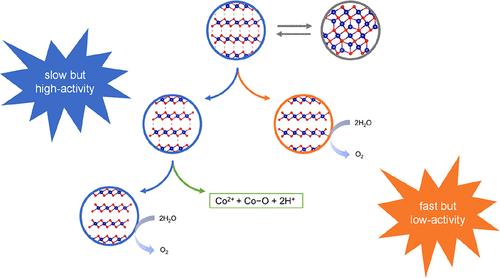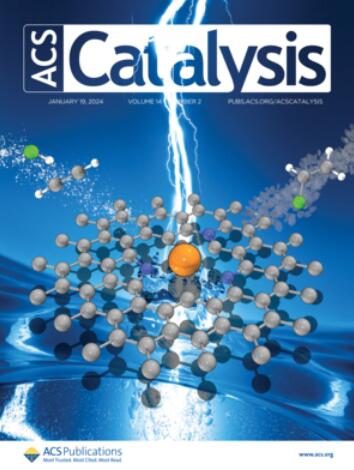Origin of Disparities in Water Oxidation between Amorphous and Crystalline Electrocatalysts
IF 11.3
1区 化学
Q1 CHEMISTRY, PHYSICAL
引用次数: 0
Abstract
Amorphous catalysts behave differently in oxygen evolution reaction (OER) performance compared with their crystalline counterparts; however, the origin of this disparity is still ambiguous. Herein, amorphous and crystalline CoOOH are invoked as the model catalysts to explore the origin of their difference in the OER performance. Electrochemical measurement results demonstrate that the amorphous CoOOH has more active sites in quantity but lower intrinsic activity per site than the crystalline CoOOH in the initial stage of the OER. Nevertheless, the intrinsic activity per site of the amorphous CoOOH continues to increase until a level close to that of the crystalline CoOOH is achieved when the OER proceeds. On the basis of operando characterizations and electrochemical analysis, a dual-pathway model of reconstruction is proposed to explain the catalytic behaviors of these CoOOH. The intrinsic activity of catalysts is dominated by two reconstruction pathways. The distinction of intrinsic activity between the amorphous and crystalline CoOOH is caused by the different proportions of each pathway included in OER. Moreover, the quenching reaction between Co4+ and the oxygen vacancy in the amorphous catalyst motivates the surface reconstruction and subsequently promotes the crystallinity. This study provides a perspective for understanding the surface reconstruction mechanism in the OER.

求助全文
约1分钟内获得全文
求助全文
来源期刊

ACS Catalysis
CHEMISTRY, PHYSICAL-
CiteScore
20.80
自引率
6.20%
发文量
1253
审稿时长
1.5 months
期刊介绍:
ACS Catalysis is an esteemed journal that publishes original research in the fields of heterogeneous catalysis, molecular catalysis, and biocatalysis. It offers broad coverage across diverse areas such as life sciences, organometallics and synthesis, photochemistry and electrochemistry, drug discovery and synthesis, materials science, environmental protection, polymer discovery and synthesis, and energy and fuels.
The scope of the journal is to showcase innovative work in various aspects of catalysis. This includes new reactions and novel synthetic approaches utilizing known catalysts, the discovery or modification of new catalysts, elucidation of catalytic mechanisms through cutting-edge investigations, practical enhancements of existing processes, as well as conceptual advances in the field. Contributions to ACS Catalysis can encompass both experimental and theoretical research focused on catalytic molecules, macromolecules, and materials that exhibit catalytic turnover.
 求助内容:
求助内容: 应助结果提醒方式:
应助结果提醒方式:


